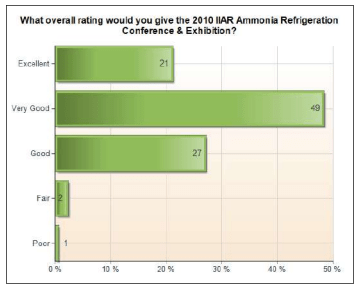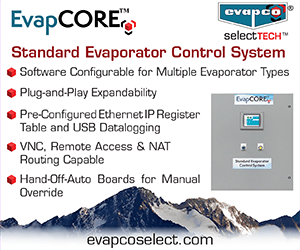Chairman’s Message
By Peter Jordan
In October 2010, the IIAR Board of Directors meets to conduct its annual strategic planning session. The two-fold purpose of the session is to: 1. Define goals for the IIAR in the upcoming year, and 2. Set in motion plans to achieve these goals.A key goal identified during the strategic planning session is to implement additional programs designed to make safe practices part of the refrigeration culture. The 2010 IIAR Industrial Refrigeration Conference & Exhibition was our first opportunity to demonstrate to our membership that we are serious about achieving this goal. We had a very successful conference with over 1,000 attendees. And, according to the post-conference survey results, more than 97% of the attendees gave the conference an overall rating of good or better.
We emphasized safe practices during the technical papers, workshops and panels presented at the conference. Several workshops focused on issues directly related to the IIAR’s recently completed Ammonia Incident Survey. For example, workshops focused on issues related to evaporative condenser maintenance and precautions which can be taken to prevent ammonia releases from flanges and joints. Two topics which were addressed at the conference, a Sight Glass Task Force Report and an ARF Relief Valve Research Project, are summarized in this issue of the Condenser.
Another important topic that received plenty of attention during the 2010 conference is the OSHA National Emphasis Program (NEP). The purpose of OSHA NEP is to reduce or eliminate workplace hazards associated with the catastrophic release of highly hazardous chemicals using a new approach for inspecting Process Safety Management (PSM)-covered facilities. On Page 10 of the Condenser you’ll find a report from IIAR Government Affairs Director Lowell Randel summarizing the results of the one-year NEP pilot program. The pilot program is well over halfway to completion. According to his report,
- As of March 16, 2010, OSHA had opened 46 inspections under the NEP. When programmed and unprogrammed inspections are combined, ammonia facilities represent 44 percent of all inspections.
- The average inspection takes roughly 100 hours for the OSHA teams to complete. By comparison, this total is about 10 percent of the time required by OSHA to conduct inspections under the NEP for Petroleum Refineries.
- Thirteen of the inspections under the Chemical Facilities NEP have closed, resulting in an average of six citations per inspection. On average, 3.5 of the citations issued were related to PSM, resulting in approximately $5,300 in penalties per inspection. Facilities should be aware that non-PSM related infractions of OSHA regulations will also be cited during NEP inspections (currently averaging 2.5 out of every 6 citations).
- For PSM related citations, the PSM element cited most frequently is Mechanical Integrity, with 13 citations. The Process Safety Information and Process Hazard Analysis elements are the second most cited elements, with nine citations apiece.
As we all know, ammonia has a sharp, irritating, pungent odor that acts as a warning agent to let us know that it is present, giving it a self-alarming nature. Ammonia can also be considered a self-limiting chemical, because that same odor that alerts us to its presence also limits us to safe levels of ammonia. Given these characteristics it is fair to ask whether this increased emphasis on safety is necessary. At first glance, the OSHA NEP inspections would appear to be an unnecessary burden on an industry that is already highly regulated.
In our efforts to promote ammonia as a “Green Refrigerant,” however, we must never lose sight of the precautions that should be taken to safely design, operate and maintain an industrial refrigeration system. There are inherent risks associated with all refrigerants including ammonia. This issue of the Condenser contains a description of two such incidents which had tragic consequences. Though neither of these incidents occurred at a facility operating an industrial refrigeration system they do demonstrate the importance of following proper safety procedures. That is why we must sometimes temper our potential criticism of increased regulatory activity with the realization that the attention these inspections focus on our daily activities may ultimately improve our industry.
Over the next few months the IIAR will continue to make additional changes designed to achieve the goals set during the 2010 strategic planning session including:
- The formation of an End User’s Task Force to identify additional end users’ needs related to the design and operation of industrial refrigeration systems.
- The development of a methods to distribute the information which was collected in the Ammonia Incident Survey to promote safety practices in our industry.
- The updating of the IIAR’s PSM and Risk Management Program guidelines to reflect lessons learned during the implementation of these programs.
- The development of additional materials to help our members as they implement effective operator training and preventive maintenance programs.
As you can see we have very ambitious goals in 2010 and 2011. Your support of the IIAR will make the completion of these goals possible. Without the active participation and support of our membership, for example, we would not have continued access to experts such as Lowell Randel and Jeff Shapiro as we strive as an industry to comply with the regulations, codes and standards which apply to us. In June, we will be mailing the annual IIAR membership renewal forms. We urge you to remember the valuable services that the IIAR has provided and will continue to provide to you as members.













